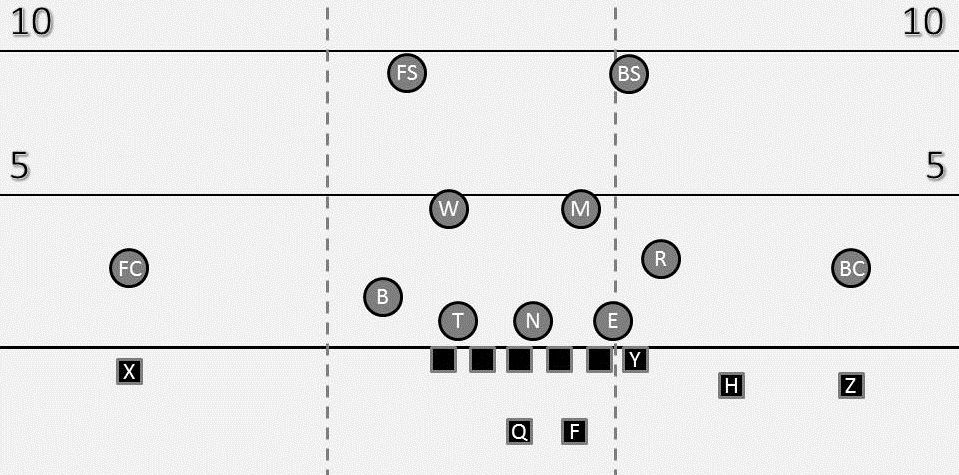With the basketball season winding down and spring football practice kicking off, it’s time to look at what the defense will look like under new defensive coordinator, David Gibbs.
From everything we have seen, Gibbs will be running a base 4-3 defense. Having said that, don’t expect it to look much different from Wallerstedt’s and Smith’s defenses these past two seasons. Let me show you what I mean.
I’m going to be dealing mostly with the base sets until we get our eyes on how this thing works. OK, let’s get it.
Wallerstedt Base 3-4
First, let’s take a look at what Texas Tech has been running these past two seasons.

Ok, this should look familiar. But as review: starting up front on the defensive line, you’ve got a 3-tech defensive tackle, a 1-tech nose tackle, and a 5-tech defensive end (the techniques are labeled inside out, starting with 0 directly over the center, 1 between center and guard, 2 directly over the guard, etc.). And then the linebackers, left to right, were Bandit, Will, Mike and Raider. Secondary (again, L to R) was Field Corner, Field Safety, Boundary Safety, and Boundary Corner (Field and Boundary designations were made based on the ball placement; field was the wide larger side when the ball wasn’t placed in the center of the field, boundary was the smaller).
For a little context, end of season starters for these positions were as follows: Keland McElrath, Tackle; Rika Levi, Nose; Branden Jackson, End; Pete Robertson, Bandit; Sam Eguavoen, Will; VJ Fehoko, Mike; Austin Stweart, Raider; Nigel Bethel, Field CB; Justis Nelson, Field Safety; Derrick Dixon, Boundary Safety; and Tevin Madison, Boundary CB.
And now that I think I finally have a grasp on the Field/Boundary alignments and who’s who, Tech is throwing that out the window.
Gibbs Base 4-3
I’m going to be starting with generic terms for the positions until I hear otherwise (UPDATE: from this morning’s A-J post, these are pretty close accurate). But it will also help with the defensive alignment, because this defense does flip side-to-side, but based on formation strength and not ball placement.

Upfront, L to R, you’ve got the 5-tech weakside defensive end (WDE), 1-tech nose, 3-tech tackle and a 5-tech strongside defensive end (SDE). Linebackers are weakside (WLB), middle (MLB) and strongside (SLB). Secondary is left CB, free safety, strong safety, and right CB. Let’s take a look at some of the immediate differences.
Along the line, you’ve got two defensive ends. This actually won’t change that much from what Wallerstedt/Smith was running because that WDE is a stand up edge rush player. We’ll get into the personnel more later, but this is basically the Bandit position, so Robertson and crew are now a part of the defensive line instead of the linebackers (DL will be coached by Mike Smith). Next, the nose will be in the 1-tech to the weakside to decrease the gap between the nose and WDE. The tackle has been flipped to the strong side (giving more numbers and heft against power running teams). And the SDE is the same as the end was in Wallerstedt’s.
Your starting defense is going to look like this:

Those not participating in spring practice and thus not in the depth chart are as follows: DT Donte Phillips, DE Andre Ross (included above, probably no. 2 behind Robertson when healthy), S J.J. Gaines, DB Jah’Shawn Johnson, CB Joseph Clark.
Having mentioned weakside and strongside, I’d like to point out that this is determined by the offensive formation. Determining, among a few other secondary tactics, starts by looking at the offensive line’s alignment, plus any tight ends, H-backs and/or fullbacks.
And this is the first improvement I like over the previous system. The defensive alignment is based on the offensive formation, and not some arbitrary placement of the ball. The previous system could be [easily] exploited by the offense setting the strength of the formation towards the field side where, generally, the defense is lighter AND have more room to work. The other big improvement I see is that it’s only the front seven moving (possibly the safeties, too) and it’s not moving the entire defense when the ball is placed on the opposite hash. Now, this could also be a little bit of a downfall, too. The defense is going to have to let the offense set, and then they adjust accordingly, whereas with the previous system they could get aligned once the ball was placed.
From everything I’ve seen, this is primarily a Cover 3 defense. Gibbs has shown he likes to drop one of the safeties into the box for nickel coverage and run support, letting the two corners and the free safety cover deep. Also from my notes, he rotates the d-line pretty often, keeping everyone fresh; linebackers and safeties don’t rotate out that much (and this may have some to do with the UH personnel). Don’t worry, I’m going to go into a lot more detail going forward.
There’s a lot more to break down here, and we’re going to take this thing apart, with hopefully more and more information coming out of spring practice as it goes along. I just wanted to give everyone a little primer to how this defense is going to be different from the scheme and look of it before we really break it down. Next time, we’re going to look at the stats and try to determine who’s going to lead this defense in what stats.









